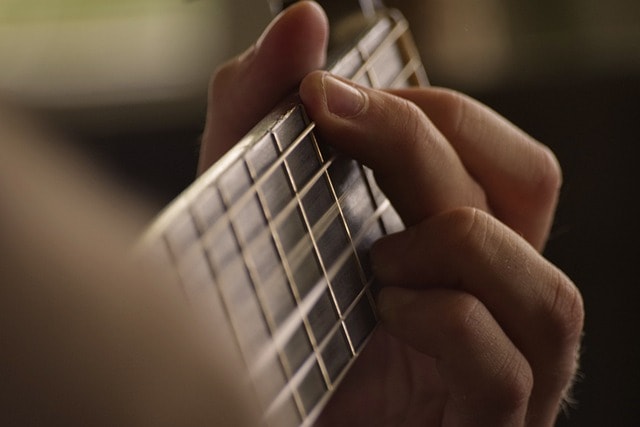Guitar music tabs, or “guitar music tab” as it’s often called, simplify learning new songs without needing to read traditional sheet music. This article will break down what guitar music tab is, how to read them, and where to find the best tabs online. Whether you’re just starting out or looking to tackle more complex pieces, we’ve got you covered.
Table of Contents
Key Takeaways
Guitar tabs are easier for beginners compared to traditional sheet music, offering a clear guide on finger placement without requiring knowledge of musical notation.
Utilize top guitar tab websites like Ultimate Guitar, Songsterr, and Guitar Pro Tabs for a wide range of songs and interactive learning tools.
Incorporating backing tracks and using specialized apps like metronomes and tab readers can significantly improve your practice sessions, timing, and overall guitar skills.
Understanding Guitar Music Tabs

Guitar tabs, or tablature, are a visual representation of the notes in a song, showing where to play these notes on the guitar. Tabs are particularly beneficial for beginners, as they:
Do not require any prior knowledge of musical notation, unlike traditional sheet music
Provide a straightforward guide to finger placement
Make it easier to start playing songs right away
Tabs are versatile, displaying both chords and single notes. This versatility allows you to learn a wide range of songs, from simple strumming patterns to intricate solos. Any guitarist aiming to broaden their song collection swiftly and effectively should comprehend guitar tabs.
In the following subsections, we’ll delve deeper into the differences between guitar tabs and sheet music and explore the key symbols used in guitar tabs.
Difference Between Guitar Tabs and Sheet Music
Sheet music uses staff notation to represent musical pitches and rhythms, which can be complex and intimidating for beginners. In contrast, guitar tabs use numbers to indicate fret positions, making them more accessible for guitarists. This direct correlation to the guitar’s layout simplifies the learning process, allowing players to focus on finger placement rather than deciphering traditional notation.
While sheet music provides detailed information about notes and rhythm, guitar tabs focus on showing which strings and frets to play, making it easier to pick up new songs quickly. This distinction is significant for novices eager to get started without the arduous learning process associated with interpreting conventional sheet music.
Key Symbols in Guitar Tabs
Guitar tabs are filled with various symbols that indicate different playing techniques. For instance, numbers on the tab lines show which fret to press on a given string, while a ‘0’ represents an open string,. Comprehending these basic symbols is key to understanding the foundational layout of guitar tabs.
More advanced symbols, such as curved arrows for string bends, ‘H’ for hammer-ons, and ‘P’ for pull-offs, provide guidance on how to perform specific techniques,. Upstrokes and downstrokes are indicated by different symbols, such as a ‘V’ for upstrokes. Familiarizing yourself with these symbols will enhance your ability to read and play tabs accurately.
How to Read Guitar Music Tabs
Reading guitar tabs involves understanding the six horizontal lines that represent the guitar strings, with the top line being the high E string and the bottom line the low E string. Numbers on these lines indicate which frets to press, and the tabs are read from left to right, displaying the chronological order of notes,.
When numbers are aligned vertically, they represent chords that should be strummed simultaneously. This straightforward visual representation makes it easier to follow along and play songs accurately. In the following subsections, we’ll break down basic tab reading skills and explore more advanced tab techniques.
Basic Tab Reading Skills
In guitar tablature:
The top line represents the high E string
The bottom line represents the low E string
A ‘0’ on a string indicates an open string, meaning it should be played without pressing any fret
Most beginner tabs only use numbers to show which fret to play, without specifying finger positions.
It’s important for beginners to start with simple tabs to familiarize themselves with the layout and the process of reading. As you gain confidence, you can move on to more complex tabs that incorporate a variety of techniques and symbols.
Advanced Tab Techniques
Advanced techniques in guitar tabs include:
String bending: indicated by a curved arrow over the note, often showing whether to bend a half or full step
Hammer-ons: marked by an ‘H’ and an arc connecting the original note to the target note
Pull-offs: shown by a ‘P’ and a similar arc
Vibrato: a technique used to add expression to a note by rapidly bending and releasing the string
These techniques can add depth and complexity to your guitar playing.
Vibrato is represented by a zig-zag line above the note, indicating that the pitch should be varied slightly. Tapping, a technique where the picking hand is used to tap the fretboard, is notated with a ‘T’ above the tapped note. Proficiency in these advanced techniques can substantially improve your performance, enabling you to handle more complex songs.
Finding the Best Guitar Music Tabs Online

Finding high-quality guitar tabs online can significantly enhance your learning experience. Websites like Ultimate Guitar, Songsterr, and Guitar Pro Tabs offer extensive tab collections, interactive players, and genre-based selections. These resources provide a wealth of material for guitarists of all levels.
In the upcoming subsections, we’ll explore top sites for acoustic guitar tabs and popular tab collections, helping you find the best resources to suit your playing style and preferences.
Top Sites for Acoustic Guitar Tabs
For acoustic guitar tabs, websites like:
GuitarNick: offers tabs for various styles and techniques
Chordie: categorizes hundreds of tabs by genre and difficulty level
Songsterr: provides high-quality tabs with an interactive player
are excellent resources.
The Acoustic Guitar Forum and National Guitar Academy also offer vast libraries of popular songs and timeless classics, along with community discussions and additional learning resources. These sites are invaluable for acoustic guitarists looking to expand their repertoire.
Learn more, visit The 8 Best Websites For Guitar Tabs
Popular Tab Collections
Ultimate Guitar is renowned for its extensive genre-based tab collections, including classic rock, 90s alternative, and many more. Chordie is another popular website offering a vast collection of tabs across various genres and difficulty levels.
These collections allow you to pick and choose tabs that match your skill level and musical interests, making it easier to find songs you’ll enjoy playing.
Using Backing Tracks to Enhance Your Playing

The use of backing tracks can markedly improve your guitar practice by:
Creating a band-like environment for solo rehearsals
Helping improve timing, rhythm, and improvisation skills
Making practice sessions more engaging and enjoyable
Enhancing your musical ear and ability to adapt to other instruments
In the following subsections, we’ll explore where to find quality backing tracks and how to integrate them with your guitar tabs for a more structured and effective practice session.
Where to Find Quality Backing Tracks
Websites like Ultimate Guitar and JamTrackCentral offer professional-quality backing tracks for various genres. Some other options include:
All Guitar Backing Tracks, which provides a library of over 1000 tracks
YouTube, which offers a wide range of free backing tracks
Spotify, which also has a variety of free backing tracks available
These platforms can be a great resource for finding backing tracks to practice and play along with.
These resources enable you to search and locate tracks tailored to your practice requirements, be it working on particular songs or polishing improvisation skills.
Integrating Tabs and Backing Tracks
To effectively use guitar tabs alongside backing tracks, follow these steps:
Learn the tabs thoroughly before playing along with the track.
Sync up tab sections with corresponding parts of the backing track to structure your practice sessions.
If you find certain sections challenging, adjust the tempo of the backing track to a slower speed to master the difficult parts.
Advanced tab reader applications featuring playback can assist you by enabling you to listen to the sound of the tab as you play along. Experimenting with different genres and improvisation techniques becomes easier when integrating tabs with backing tracks.
Tools and Apps to Improve Guitar Tab Reading
Using specialized tools and apps can significantly enhance your ability to read and play tabs accurately. Apps like Guitar Pro and YouTube tutorials simplify the process of learning and practicing guitar tabs, making it more efficient,.
In the following subsections, we will discuss the benefits of metronome apps for maintaining rhythm and tab reader apps for displaying and interacting with tabs.
Metronome Apps
Metronome apps are crucial for maintaining consistent rhythm during practice. Apps like Soundbrenner Metronome and Pro Metronome offer features such as adjustable time signatures, tempo control, and visual cues, making them versatile for various practice needs,. Utilizing a metronome can aid in progressively enhancing your speed as your skill level advances.
These apps are portable and cost-effective compared to traditional metronomes, providing an essential tool for any guitarist looking to improve their timing and tone.
Tab Reader Apps
Tab reader apps display guitar tabs clearly, allowing you to follow along while playing. Apps like TabToolkit and Songsterr offer interactive playback features, making it easier to learn new songs,.
Some tab reader apps also synchronize with cloud storage, allowing you to access your tabs across multiple devices. Chordly, for example, lets you download tabs directly as PDFs for easy printing and offline use,.
Sharing and Printing Guitar Music Tabs
The ability to share and print guitar tabs can augment your practice sessions and facilitate cooperation with fellow musicians. Websites like Musicnotes allow you to download and print tabs for offline use, ensuring you have access to your music anytime,.
In the following subsections, we will explore the best ways to share tabs and tips for printing tabs with proper formatting.
Best Ways to Share Tabs
Sharing tabs can be done in several ways:
Via email or social media by copying the tab link from the website
Platforms like Ultimate Guitar allow you to upload and share your tabs with a community of guitarists
Collaborative features on websites like Chordly enable multiple users to work on the same tab simultaneously, facilitating projects and enhancing the experience.
Investigating various platforms and strategies for sharing guitar tabs online can significantly boost your engagement with other guitar players.
Printing Tabs for Easy Access
Printing tabs with proper formatting ensures they are easy to read and use during practice. Using a browser like Google Chrome can resolve compatibility issues with the print function on some tab websites. Before printing, increase the font size on the website to generate a more readable tab.
Tabs that are correctly formatted and printed offer a physical resource that you can reference without resorting to digital devices. This accessibility is particularly useful during practice sessions, allowing you to focus entirely on your playing.
Overcoming Common Challenges in Reading Guitar Tabs
For beginners, the process of reading guitar tabs can pose multiple challenges. Tabs often lack comprehensive musical context, which can be confusing. Listening to the song while following the tab, studying sheet music for the same song, or using tab reader apps with playback features can help bridge this gap.
Mastering complex fingerings and transitions in tabs can be challenging, often leading to difficulty in maintaining a smooth performance. Practicing slowly, breaking down challenging sections, and using finger exercises can improve agility and help you overcome these hurdles. In the following subsections, we’ll delve into strategies for dealing with complex tabs and improving finger placement.
Dealing with Complex Tabs
Segmenting complex tabs into smaller, more manageable parts can make them less intimidating. Practice each section individually until you master it. Slowing down the tempo also allows for better precision in playing intricate parts, ensuring accuracy before gradually increasing speed.
Focusing separately on timing and rhythms can aid in mastering complex tabs. Looping tricky parts repeatedly until they become second nature is a beneficial strategy for overcoming difficult sections.
Improving Finger Placement
Better finger placement can be achieved by practising exercises with simple melodies and scales, thus improving accuracy and agility. Paying attention to finger transitions between chords can improve smoothness in your playing. Maintaining a relaxed hand position helps in smooth fingers transitions, reducing finger strain and enhancing overall performance.
Consistent practice and attention to finger placement aid in memorizing tab positions, leading to more accurate and fluid playing.
Summary
Understanding and utilizing guitar tabs can transform your guitar playing journey. From grasping the basics of tab reading to mastering advanced techniques, each step brings you closer to playing your favorite songs with confidence. Reliable online resources, tools, and apps provide invaluable support in this learning process.
Regular practice, coupled with the integration of backing tracks and consistent use of tools, will enhance your skills and enjoyment of playing the guitar. Embrace these resources, and watch your guitar playing flourish. Keep practicing, exploring, and most importantly, have fun!
Frequently Asked Questions
What are guitar tabs, and how do they differ from sheet music?
Guitar tabs are a visual guide for playing notes on the guitar, using numbers for fret positions, making them more accessible for guitarists compared to sheet music. So, they are easier to follow and understand when learning new songs.
What are some key symbols used in guitar tabs?
Key symbols in guitar tabs include numbers for fret positions, ‘0’ for open strings, curved arrows for string bends, ‘H’ for hammer-ons, ‘P’ for pull-offs, and zig-zag lines for vibrato. These symbols help you understand how to play specific techniques and notes on the guitar.
Where can I find high-quality acoustic guitar tabs online?
You can find high-quality acoustic guitar tabs online on websites like GuitarNick, Chordie, Songsterr, and National Guitar Academy. Enjoy exploring these resources to find the perfect tabs for you!
How can backing tracks improve my guitar playing?
Backing tracks can improve your guitar playing by providing a band-like experience that helps with timing, rhythm, and improvisation skills, making practice sessions more engaging and effective. Overall, they allow you to better understand how individual notes and chords fit within a full arrangement. So why not give backing tracks a try?
What tools and apps can help me read guitar tabs more effectively?
You can enhance your guitar tab reading skills by using tools and apps like Guitar Pro, Soundbrenner Metronome, Pro Metronome, TabToolkit, and Songsterr, which offer interactive playback features and extensive tab libraries. Try them out and see your skills improve!









